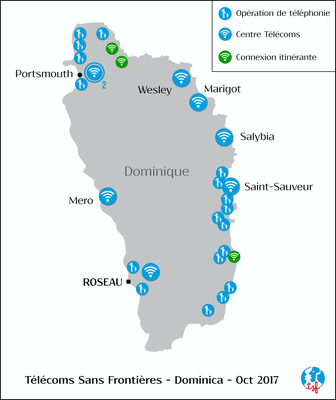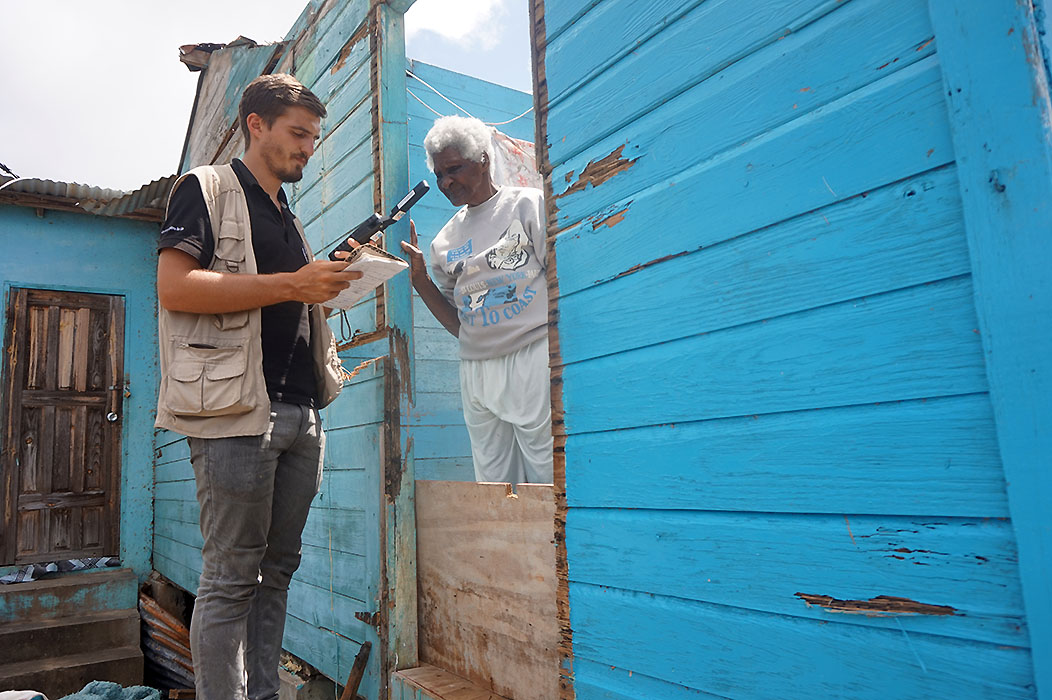Hurricane Maria
Context: Hurricane
Start date: 20/09/2017
End date: 18/02/2018
Areas of intervention: 6 parishes
- St Andrew
- St David
- St George
- St John
- St Joseph
- St Patrick
Activities:
- Support to coordination
- Connectivity for populations
- Capacity building
5 satellites lines strategically positioned
9 NGOs & agencies supported
86 GB of data exchanged for humanitarian coordination
6 Wi-Fi points for population
7 447 users unique
3.2 TB of data used by population
3 ambulant Wi-Fi operations
272 users unique
13 GB of data used by population
20 calling operations
910 beneficiaries
Context
Less than a week after Hurricane Irma hit the Caribbean in early September, a second Category 5 hurricane, Maria, swept across the region on 19th September. Dominica, which is particularly vulnerable due to its topography and poor development, had been devastated by winds reaching 260 km/h and torrential rains. In less than 24 hours, nearly 90% of the infrastructure was rendered inoperative, leaving 73,000 inhabitants cut off from the world.
The telecom infrastructure was severely affected: GSM antennas destroyed, landslides having removed portions of the underground interconnection network, submersion of the MNOs’ generators and destruction of the arrival point of the Eastern Caribbean Fiber System (ECFS).
Deployment
Télécoms Sans Frontières, operating on the neighbouring islands of Saint-Martin and Saint-Barthélemy in response to Hurricane Irma, remobilised part of its team in the direct aftermath of Maria in order to reach Dominica as quickly as possible.
With Dominican airports and commercial shipping links closed, TSF relied on the mobilisation of Guadeloupian volunteers to reach Dominica by sea, and thus be among the first humanitarian actors to reach the island on 21st September.
Faced with the difficulties caused by the absence of telecoms, TSF supported relief organisations and the affected populations across the island.
Support to coordination
The first priority was to facilitate the arrival of specialized humanitarian teams in the vital sectors: medical, food, water, sanitation and civil engineering. TSF participated in the establishment of the international operating centre at Windsor Park Stadium, in the capital Roseau, by installing a broadband Internet connection via satellite. The TSF connection was even more essential since the stadium had been converted into a heliport, and thus was the starting point for all distribution operations.
It also allowed the French (SAMU, firemen of Guyana and Martinique, consular office of the French Embassy, Alliance Française, Ministry of Foreign Affairs) and international (ECHO, EUCP, UNDP, Dominican government) relief actors to organize and coordinate their land and helicoptered operations.
In response to the continued influx of humanitarian staff, the deployment of emergency Internet connections was coordinated with the Emergency Telecommunications Cluster (ETC) and the Telecommunications Working Group (TWG), led by the Ministry of Telecommunications of Dominica. The latter requested the support of humanitarian agencies and NGOs to deploy satellite phones in strategic locations so that local officials could communicate with the national authorities in Roseau.
The telecommunication response capacity was distributed in a coherent and coordinated way according to the needs. TSF was responsible for re-establishing communications in Portsmouth, the second largest city north of the island.
A satellite internet connection installed for the population was extended by radio link to the Portsmouth Hospital, a few hundred meters away. This connectivity was vital for medical staff to contact drug resupply centres in Roseau and organize urgent medical transfers.
Connectivity for population
Internet hotspots
As early as 25th September, the team deployed in Portsmouth provided a Wi-Fi Internet hotspot, in collaboration with an amateur radio operator who was involved in the community response notably by providing an charging service. This vital connectivity enabled residents to contact their relatives and organise the assistance they required via social networks, SMS, phone calls and videos.
In less than 24 hours, 317 families had already registered on the network, accounting for nearly one third of the city's population. Evaluations found that the main communication channels used were mobile applications such as WhatsApp and Messenger. TSF optimised its connections to ensure that messages via such platforms could still be exchanged when several dozen devices were connected to the network simultaneously.
The population also benefited from Wi-Fi hotspots in the cities of Wesley, Marigot and Salybia to communicate and stay informed.
Three months after the hurricane, the means of communication were only partially restored in some parts of the island. While a majority of the civilians depended on landlines, these were not to be restored for several months. The population still expressed the need to benefit from Internet access due to the difficulties in making phone calls or connecting to the Internet via 3G or 4G networks.
In December, thanks to the partial restoration of mobile networks, the Internet connections in Wesley and Portsmouth were relocated to the out-of-coverage towns of Saint Sauveur and Mero.
Ambulant Wi-Fi service
Faced with the scale of the disaster and the difficulties people had in moving around, TSF launched a new service to bring the technologies closer to communities. On 5th October, high-speed ambulant Wi-Fi services were tested in the most remote areas.
Equipped with a 4x4 and a mobile satellite antenna, TSF travelled from village to village to provide residents with access to social networks, instant messaging applications and news sites. Adapting to new telecommunications uses is essential to best meet the needs on the ground.
On the first day, the team covered the villages of Vieille Case and Thibaud. The operation was replicated the following day in the city of La Plaine allowing 272 people to access to Internet.
Humanitarian calling operations
As GSM networks were affected in most parts of the island, the populations were unable to make or receive calls. In places where network coverage was sporadic, it was mostly saturated, unstable, and frequently people lacked telephone credit or had lost their phone.
In light of these problems, TSF conducted dozens of humanitarian calling operations offering satellite calls across the island, even in the most remote villages. 910 beneficiaries were able to contact their relatives and inform them of their situation and needs. The vast majority of calls went to the United States, Guadeloupe, the United Kingdom and Antigua.
In parallel, TSF offered a charging solution to help those who could not charge their phone battery.

Disaster response preparation
With the aim of limiting the impact of natural hazards in high-risk areas such as Dominica, TSF supported the strengthening of the Government’s telecommunication response capacity.
TSF donated satellite equipment to establish emergency Internet connections. In addition, training was provided to officials of the Ministry of Information, Telecommunications Sciences and Technology to strengthen their autonomy in the event of a new crisis.



































